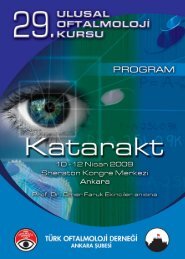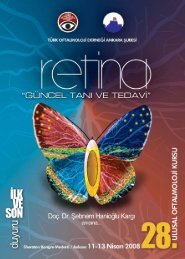Book
ABSTRACT BOOK.qxd
ABSTRACT BOOK.qxd
- No tags were found...
You also want an ePaper? Increase the reach of your titles
YUMPU automatically turns print PDFs into web optimized ePapers that Google loves.
Abstract <strong>Book</strong><br />
U n ive rs i t a rio de Va l e n c i a ), G a rc i a - D e l p e ch Salva d o r<br />
(Hospital General Universitario de Valencia), Amselem Luis<br />
(Hospital General Universitario de Valencia)<br />
Introduction and Objectives: To compare the safety and<br />
effcacy of Daclizumab and Infliximab for the treatment of<br />
uncontrolled noninfectious intermediate uveitis, posterior<br />
uveitis and panuveítis.<br />
Methods: Prospective nonrandomized interventional trial<br />
over 20 patients with noninfectious intermediate uveitis, posterior<br />
uveitis and panuveítis with a history of at least one<br />
relapse in their ocular inflammation during 6 months prior to<br />
the beginning of the study in spite of treatment with systemic<br />
corticosteroids and 1 or more immunosuppressive drugs. 10<br />
patients were treated with Daclizumab (1mg/kg) every 4<br />
weeks and 10 more patients were treated with Infliximab<br />
(5mg/kg) every 8 weeks. The groups were equally distributed<br />
regarding the type of the uveitis and the systemic immunosuppression<br />
medication load. The main outcome measures<br />
were the Early Treatment of Diabetic Study (EDTRS) visual<br />
acuity, the systemic immunosuppression medication load and<br />
the ocular inflammation using standardized grading scales.<br />
Patients were examined every 3 months for a follow-up time<br />
of 12 moths.<br />
Results: 7 of 10 patients (70%) in the Daclizumab treatment<br />
group didn’t show any relapse of their ocular inflammation,<br />
6 patients of the Daclizumab treatment group reduced their<br />
systemic corticosteroid dose until 5 mg/day. 10 of 10 patients<br />
(100%) in the Infliximab treatment group didn’t show any<br />
re l apse of their ocular infl a m m ation. 8 patients of the<br />
Infliximab treatment group reduced their systemic corticosteroid<br />
dose until 5 mg/day. No side effects were observed<br />
during the follow-up in any of the groups, but Infliximab<br />
s h owed some minor re a c t i o n s , l i ke hypotension and<br />
h e a d a ch e, d u ring the administration of the medicat i o n .<br />
Conclusions: Infliximab had a higher rate of success in controlling<br />
the ocular inflammation in these patients and it was<br />
clearly more effective in patients with Behçet disease. No<br />
serious side effects were observed with Daclizumab and<br />
Infliximab but caution is needed during the administration of<br />
Infliximab.<br />
Financial fundings: None<br />
Conflict of interest: The authors have no financial interest<br />
in this study<br />
Keywords: Daclizumab, Infliximab, Noninfectious Uveitis<br />
PO3-24-07<br />
EVALUATION OF SAFETY AND EFFICACY OF<br />
ADALIMUMAB IN THE TREATMENT OF NONIN-<br />
FECTIOUS UVEITIS.<br />
Diaz-Llopis Manuel (Hospital General Unive rs i t a rio de<br />
Va l e n c i a , S p a i n ), Salom David (Hospital Genera l<br />
Universitario de Valencia, Spain), Amselem Luis (Hospital<br />
General Universitario de Valencia, Spain), Udaondo Patricia<br />
(Hospital General Universitario de Valencia, Spain), Garcia-<br />
D e l p e ch Salvador (Hospital General Unive rs i t a rio de<br />
Va l e n c i a , S p a i n ), H e rn a n d e z - G a r fella Marisa (Hospital<br />
General Universitario de Valencia, Spain)<br />
I n t roduction and Objective s : A d a l i mu m ab is a 100%<br />
h u m a n i zed monoclonal antibody with an anti Tu m o r<br />
Necrosis Factor (TNF) activity with the advantage of the subcutaneous<br />
administration. The purpose of this study is to<br />
evaluate the efficacy and safety of subcutaneous adalimumab<br />
for therapy-resistant uveitis.<br />
Methods: Nineteen consecutive patients with bilateral, sightthreatening,<br />
non-infectious uveitis with chronic dependence<br />
on immunosuppressive drugs were treated with adalimumab<br />
40 mg every other week for one year. Main outcome measures:<br />
1) Best-corrected visual acuity; 2) Degree of ocular<br />
i n fl a m m ation ;3) Ability to reduce immu n o s u p p re s s ive<br />
d rugs; 4) Lack of clinical re c u rrences; 5) Macular<br />
edema(OCT). Clinical success was judged by the composite<br />
clinical end point of the five different outcome measures.<br />
R e s u l t s : All patients demonstrated a rapid and go o d<br />
response. Nineteen patients (100%) met criteria for clinical<br />
success at the one year follow-up. Visual acuity: 30 of 38<br />
eyes (78.94%) improved, 6 eyes (15.78%) presented no<br />
change and 2 eyes (5.26%) had continued visual loss.<br />
A n t e rior seg m e n t : 21 eyes (55.26%) presented re d u c e d<br />
inflammation and 17 eyes (44.73%) had no change. Posterior<br />
segment: 29 eyes (76.31%) had demonstrated rapid response<br />
and achieved disease improvement, 9 eyes (23.68%) presented<br />
no change, and no eyes worsened. Concomitant immunosuppressive<br />
drugs were reduced by at least 50% in 19<br />
p atients (100%) and there we re no seve re re c u rre n c e s .<br />
Macular thickness was significantly reduced from 390.63 ±<br />
138.18 μ to 241.05 ± 64.63 μ (p < 0.05) at the end of followup.<br />
No adverse effects were observed.<br />
Conclusions: Adalimumab seems to be an effective and safe<br />
t h e rapy for the management of re f ra c t o ry uve i t i s , a n d<br />
appears to reduce the need for concomitant immunosuppressive<br />
treatment.<br />
Financial fundings: None<br />
Conflict of interest : The authors have no financial interest<br />
in this study<br />
Keywords: Adalimumab, Noninfectious uveitis, Treatment<br />
9 th International Ocular Inflammation Society (IOIS) Congress<br />
September 17-20, 2007, Paris, France<br />
179





